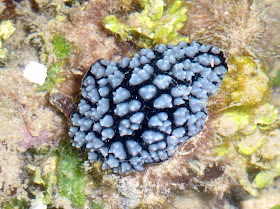
And indeed, there were corals that had bleached such as this Cauliflower coral (Pocillopora sp.). The Cauliflower coral seems to be one of the most badly hit species by the bleaching event.

However, on a closer look at this colony, one can see that the polyps are still alive with tentacles sticking out. The resident animals in the corals such as the porcelain crab and the transparent looking shrimp are still in it.
Which means that the coral is still alive, holding to a chance of recovery if conditions of the waters return back to normal- allowing the photosymbiotic algae to return back to the corals.

The boulder corals such as the Brain coral (Family Mussidae) and the Favid hard corals (Family Faviidae) have not been completely bleached but is losing its colour.

However, the lagoon seems to have more unbleached hard corals than bleached ones, which is a relief.

Even most of the Leathery soft corals (Family Alcyoniidae) are still looking ok- no off white coloration.

I had a quick look at the resident Burrowing Giant Clam (Tridacna crocea). Glad to see that clams are quite resilient against bleaching and it is as pretty as ever.
After which, we walked out of the seawall to look at the corals at the reef edge.

And this is the sight that greeted us. More corals that bleached than unbleached. Oh dear!

Even the Zoanthids are not spared! Look at the white dots at the bottom left, they are the bleached zoanthids.

Some hard corals such as the Mushroom corals and the Carnation coral (Pectinia sp.) are quite badly affected.

Here's a group of three Circular mushroom corals, in different extent of bleaching. Sad to say, I saw more bleached than healthy ones.

Here's an even more dismay sight- 9 Circular mushroom corals in pale yellow colour.

The Leathery soft corals (Family Alcyoniidae) at the reef edge is not doing as well as those in the lagoon.
This is puzzling, why would corals at the edge respond worse than those in the lagoon? Shouldn't they be in the deeper waters and thus more shading from the sun? Or is it because those in the lagoon are already very tough in nature since these corals have to endure more physical stress in normal times?

Other than soft corals, the Sea mat zoanthids (Palythoa tuberculosa) are also affected.

While bleaching is extensive, there are still some parts of the reef with some unbleached corals.

Here are some boulder hard corals that still have its colour.

As well as these Mushroom corals that look just as healthy as they were in the past.

Interestingly, many colonies of the Lettuce coral (Pavona sp.) seem to show up as one of the toughest species, a phenomenon that is similar to that of Tanah Merah's reef.

There are also some colonies of Carnation coral (Pectinia sp.) that were still hanging on.
So much for the bleaching, the reef is still very much alive with other animals that is not related to bleaching.

Such as this Blue-lined flatworm (Pseudoceros sp.)

And this Orange-edged black flatworm (Pseudobiceros uniarborensis).

In addition, there are also many pretty nudibranchs that roam the reefs such as this Black phyllid nudibranch (Phyllidiella nigra) with purplish bumps.

And also this Pimply phyllid nudibranch (Phyllidiella pustulosa).

James had a special find of the Arabian cowrie (Cypraea arabica). This is a large cowrie that is rare in our southern shores.

I found this living Scallop (Family Pectinidae)! They have well developed but tiny pinkish eyes along the mantle edge. It went swimming for a while by flapping its shells and it was exciting seeing it swim.

There were a number of crabs and one of my favourites will be this Mosaic reef crab (Lophozozymus pictor)- the most poisonous crab in Singapore!

As for fishes, I encountered a couple of filefishes such as this Bristle tail filefish.

This Feathery filefish (Chaetodermis penicilligerus) is a rarer filefish and is quite big. This filefish has thick feathery extensions all over the body.

Pulau Hantu has one of the best reefs of our Southern waters and I hope that they will recover from the bleaching event soon. The reef will survive, just like that from the 1998 coral bleaching event. We look forward to their recovery!
More photos from the day's trip: http://www.flickr.com/photos/koksheng/archives/date-posted/2010/06/27/
No comments:
Post a Comment